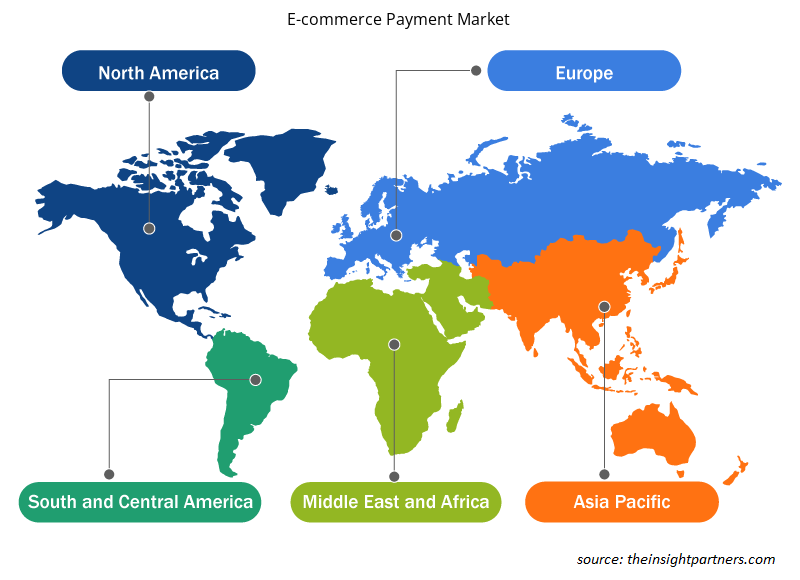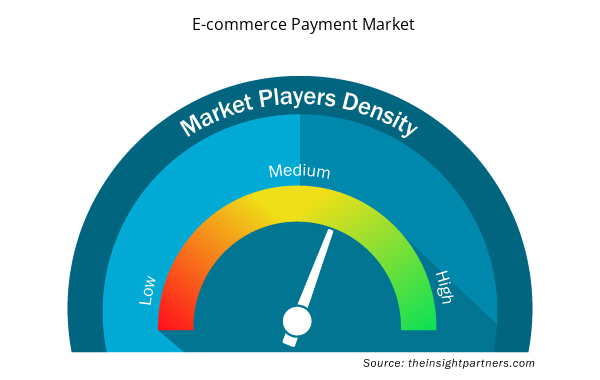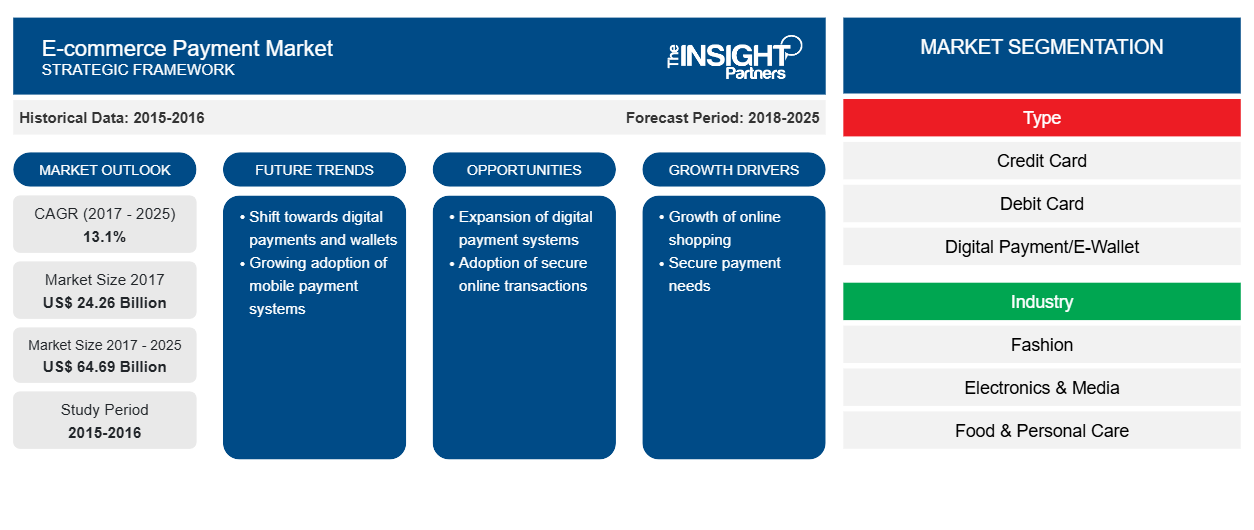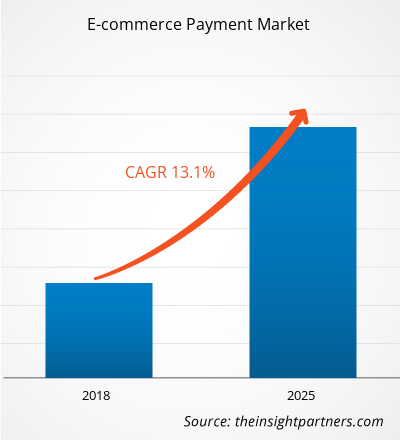Der globale E-Commerce-Zahlungsmarkt soll von 24,26 Milliarden US-Dollar im Jahr 2017 auf 64,69 Milliarden US-Dollar im Jahr 2025 wachsen, was einer durchschnittlichen jährlichen Wachstumsrate (CAGR) von 13,1 % zwischen 2018 und 2025 entspricht.
Der E-Commerce-Zahlungsmarkt wächst weltweit, wobei Online-Zahlungen aufgrund der Verfügbarkeit mehrerer Zahlungsmethoden immer beliebter werden. Darüber hinaus treiben die zunehmende Verbreitung von Smartphones und die Verfügbarkeit des Internets das Wachstum des E-Commerce-Zahlungsmarktes voran. Darüber hinaus wird erwartet, dass der E-Commerce-Zahlungsmarkt im Prognosezeitraum aufgrund der zunehmenden Zahl von Bankkunden und der Digitalisierung florieren wird. Der Bericht konzentriert sich auf eine detaillierte Segmentierung des E-Commerce-Zahlungsmarktes nach Typ, Branche und Geografie.
Markteinblicke
APAC gilt im gesamten Prognosezeitraum als führende Region
Der asiatisch-pazifische Raum umfasst mehrere Entwicklungsländer wie Südkorea, Indien, Indonesien und Malaysia. Diese Länder verzeichnen ein starkes Bevölkerungswachstum, was zu einem Wachstum des E-Commerce-Zahlungsmarktes führt. Die E-Commerce-Branche der Region blüht mit der zunehmenden Verbreitung des Internets sowie der hohen Verbreitung von Smartphones und Tablets. Außerdem ergreifen die Regierungen der Schwellenländer Initiativen zur Verbesserung der Bankgeschäfte und bieten so der Online-Zahlungsbranche eine bessere Plattform. In letzter Zeit ist ein Wandel zu beobachten, bei dem Verbraucher im gesamten APAC-Raum lieber online mit alternativen Zahlungsmethoden wie E-Wallets, Banküberweisungen und Kredit- und Debitkarten bezahlen. Die zunehmende Verwendung dieser Zahlungsmethoden wird voraussichtlich im Prognosezeitraum erheblich zum Wachstum der Zahlungsgateways in der E-Commerce-Branche beitragen. Diese Faktoren werden voraussichtlich die Nachfrage nach E-Commerce-Zahlungsmärkten im APAC-Raum weiter ankurbeln.
Passen Sie diesen Bericht Ihren Anforderungen an
Sie erhalten kostenlos individuelle Anpassungen an jedem Bericht, einschließlich Teilen dieses Berichts oder einer Analyse auf Länderebene, eines Excel-Datenpakets sowie tolle Angebote und Rabatte für Start-ups und Universitäten.
- Holen Sie sich die wichtigsten Markttrends aus diesem Bericht.Dieses KOSTENLOSE Beispiel umfasst eine Datenanalyse von Markttrends bis hin zu Schätzungen und Prognosen.
Das Geschäftsmodell im Einzelhandel bleibt im Nahen Osten ungenutzt und bietet somit ein enormes Potenzial für Branchenakteure
Digitale Zahlungen im Nahen Osten stehen an einem Wendepunkt, da Paradigmenwechsel in Regulierung, Kultur und Technologie stattfinden, die innovativen Unternehmen die Möglichkeit eröffnen, die ältesten Zahlungsökosysteme aufzumischen. Mehr als 80 % der Zahlungen im stationären Einzelhandel und 65 % der Zahlungen im E-Commerce werden immer noch in bar getätigt, und in mehreren Ländern liegt die Verbreitung von Smartphones bei über 100 %. Die Verbreitung mobiler Geräte in der MEA-Region steht am Beginn einer neuen Ära, die von sich entwickelndem Verbraucherverhalten, schneller Industrialisierung, Regierungsambitionen und sich ändernden wirtschaftlichen Bedingungen angetrieben wird. Die Chancen liegen im Wachstum des Datenzugriffs und der Umsätze, die beträchtlich werden und stark wachsen, sowie in den digitalen Zahlungsdiensten. Dies wird durch die Tatsache bestätigt, dass die Verbreitung von Smartphones in der Region bei über 65 % liegt. Darüber hinaus nutzen mehr als zwei Drittel der Bevölkerung das Internet, wobei die Verbreitung in den Vereinigten Arabischen Emiraten und Katar bei über 90 % liegt. Die Region hat eine beträchtliche Bevölkerung wohlhabender Personen mit einem Appetit auf Luxusgüter.
Die Marktinitiative wurde als die am häufigsten angewandte Strategie im globalen E-Commerce-Zahlungsmarkt angesehen. Einige der jüngsten Strategien einiger Akteure im E-Commerce-Zahlungsmarkt sind unten aufgeführt:
2018: PayPal gab die Verlängerung seiner Partnerschaftsvereinbarung mit eBay bekannt. Durch diese Vereinbarung fördert und akzeptiert eBay weiterhin PayPal Credit über die Marktplatzplattform.
2018: Alipay gab Ende dieses Jahres die Einführung in 20 europäischen Ländern bekannt. Das Unternehmen unterzeichnete Verträge mit über 40 Unternehmen für digitale Geldbörsen und 100 Banken in ganz Europa.
2018: Visa, Inc. gab die Ausweitung seiner Partnerschaft mit PayPal auf Kanada bekannt, um die Implementierung zuverlässiger, sicherer und angemessener mobiler und digitaler Zahlungen für Händler und Verbraucher zu beschleunigen.
Regionale Einblicke in den E-Commerce-Zahlungsmarkt
Die regionalen Trends und Faktoren, die den E-Commerce-Zahlungsmarkt während des Prognosezeitraums beeinflussen, wurden von den Analysten von Insight Partners ausführlich erläutert. In diesem Abschnitt werden auch die Segmente und Geografie des E-Commerce-Zahlungsmarkts in Nordamerika, Europa, im asiatisch-pazifischen Raum, im Nahen Osten und Afrika sowie in Süd- und Mittelamerika erörtert.

- Erhalten Sie regionale Daten zum E-Commerce-Zahlungsmarkt
Umfang des E-Commerce-Zahlungsmarktberichts
| Berichtsattribut | Details |
|---|---|
| Marktgröße im Jahr 2017 | 24,26 Milliarden US-Dollar |
| Marktgröße bis 2025 | 64,69 Milliarden US-Dollar |
| Globale CAGR (2017 - 2025) | 13,1 % |
| Historische Daten | 2015–2016 |
| Prognosezeitraum | 2018–2025 |
| Abgedeckte Segmente | Nach Typ
|
| Abgedeckte Regionen und Länder | Nordamerika
|
| Marktführer und wichtige Unternehmensprofile |
|
Marktteilnehmerdichte: Der Einfluss auf die Geschäftsdynamik
Der Markt für E-Commerce-Zahlungen wächst rasant. Die Nachfrage der Endnutzer steigt aufgrund von Faktoren wie sich entwickelnden Verbraucherpräferenzen, technologischen Fortschritten und einem größeren Bewusstsein für die Vorteile des Produkts. Mit der steigenden Nachfrage erweitern Unternehmen ihr Angebot, entwickeln Innovationen, um die Bedürfnisse der Verbraucher zu erfüllen, und nutzen neue Trends, was das Marktwachstum weiter ankurbelt.
Die Marktteilnehmerdichte bezieht sich auf die Verteilung der Firmen oder Unternehmen, die in einem bestimmten Markt oder einer bestimmten Branche tätig sind. Sie gibt an, wie viele Wettbewerber (Marktteilnehmer) in einem bestimmten Marktraum im Verhältnis zu seiner Größe oder seinem gesamten Marktwert präsent sind.
Die wichtigsten Unternehmen auf dem E-Commerce-Zahlungsmarkt sind:
- PayPal Holdings, Inc.
- Amazon Payments, Inc.
- CCBill, LLC
- WePay Inc.
- Alipay
Haftungsausschluss : Die oben aufgeführten Unternehmen sind nicht in einer bestimmten Reihenfolge aufgeführt.

- Überblick über die wichtigsten Akteure auf dem E-Commerce-Zahlungsmarkt
Globale Marktsegmentierung für E-Commerce-Zahlungen
Nach Typ
- Kreditkarte
- Debitkarte
- Digitale Zahlung/ E-Wallet
- Online-Banking
- Geschenkkarten
- Sonstiges
Nach Branche
- Mode
- Elektronik & Medien
- Lebensmittel und Körperpflege
- Möbel und Geräte
- Dienstleistungsbranche
- Sonstiges
Nach Geografie
Nordamerika
- UNS
- Kanada
- Mexiko
Europa
- Frankreich
- Deutschland
- Italien
- Spanien
- Vereinigtes Königreich
- Restliches Europa
Asien-Pazifik (APAC)
- Australien
- China
- Indien
- Japan
- Restlicher Asien-Pazifik-Raum
Naher Osten und Afrika (MEA)
- Saudi-Arabien
- Vereinigte Arabische Emirate
- Südafrika
- Rest von MEA
Südamerika (SAM)
- Brasilien
- Rest von SAM
Firmenprofile
- PayPal Holdings, Inc.
- Amazon Payments, Inc.
- CCBill, LLC
- WePay Inc.
- Alipay
- Visa, Inc.
- MasterCard Incorporated
- Stripe Inc.
- American Express-Unternehmen
- UnionPay International Co., Ltd.
- Historische Analyse (2 Jahre), Basisjahr, Prognose (7 Jahre) mit CAGR
- PEST- und SWOT-Analyse
- Marktgröße Wert/Volumen – Global, Regional, Land
- Branche und Wettbewerbsumfeld
- Excel-Datensatz


- Oxy-fuel Combustion Technology Market
- Digital Pathology Market
- Micro-Surgical Robot Market
- Predictive Maintenance Market
- Aircraft Landing Gear Market
- Industrial Inkjet Printers Market
- Small Molecule Drug Discovery Market
- Analog-to-Digital Converter Market
- Influenza Vaccines Market
- Lyophilization Services for Biopharmaceuticals Market

Report Coverage
Revenue forecast, Company Analysis, Industry landscape, Growth factors, and Trends

Segment Covered
This text is related
to segments covered.

Regional Scope
North America, Europe, Asia Pacific, Middle East & Africa, South & Central America

Country Scope
This text is related
to country scope.
Trends and growth analysis reports related to Banking, Financial Services, and Insurance : READ MORE..
The List of Companies
1. PayPal Holdings, Inc.
2. Amazon Payments, Inc.
3. CCBill, LLC
4. WePay Inc.
5. Alipay
6. Visa, Inc.
7. MasterCard Incorporated
8. Stripe Inc.
9. American Express Company
10. UnionPay International Co., Ltd.
The Insight Partners performs research in 4 major stages: Data Collection & Secondary Research, Primary Research, Data Analysis and Data Triangulation & Final Review.
- Data Collection and Secondary Research:
As a market research and consulting firm operating from a decade, we have published and advised several client across the globe. First step for any study will start with an assessment of currently available data and insights from existing reports. Further, historical and current market information is collected from Investor Presentations, Annual Reports, SEC Filings, etc., and other information related to company’s performance and market positioning are gathered from Paid Databases (Factiva, Hoovers, and Reuters) and various other publications available in public domain.
Several associations trade associates, technical forums, institutes, societies and organization are accessed to gain technical as well as market related insights through their publications such as research papers, blogs and press releases related to the studies are referred to get cues about the market. Further, white papers, journals, magazines, and other news articles published in last 3 years are scrutinized and analyzed to understand the current market trends.
- Primary Research:
The primarily interview analysis comprise of data obtained from industry participants interview and answers to survey questions gathered by in-house primary team.
For primary research, interviews are conducted with industry experts/CEOs/Marketing Managers/VPs/Subject Matter Experts from both demand and supply side to get a 360-degree view of the market. The primary team conducts several interviews based on the complexity of the markets to understand the various market trends and dynamics which makes research more credible and precise.
A typical research interview fulfils the following functions:
- Provides first-hand information on the market size, market trends, growth trends, competitive landscape, and outlook
- Validates and strengthens in-house secondary research findings
- Develops the analysis team’s expertise and market understanding
Primary research involves email interactions and telephone interviews for each market, category, segment, and sub-segment across geographies. The participants who typically take part in such a process include, but are not limited to:
- Industry participants: VPs, business development managers, market intelligence managers and national sales managers
- Outside experts: Valuation experts, research analysts and key opinion leaders specializing in the electronics and semiconductor industry.
Below is the breakup of our primary respondents by company, designation, and region:

Once we receive the confirmation from primary research sources or primary respondents, we finalize the base year market estimation and forecast the data as per the macroeconomic and microeconomic factors assessed during data collection.
- Data Analysis:
Once data is validated through both secondary as well as primary respondents, we finalize the market estimations by hypothesis formulation and factor analysis at regional and country level.
- Macro-Economic Factor Analysis:
We analyse macroeconomic indicators such the gross domestic product (GDP), increase in the demand for goods and services across industries, technological advancement, regional economic growth, governmental policies, the influence of COVID-19, PEST analysis, and other aspects. This analysis aids in setting benchmarks for various nations/regions and approximating market splits. Additionally, the general trend of the aforementioned components aid in determining the market's development possibilities.
- Country Level Data:
Various factors that are especially aligned to the country are taken into account to determine the market size for a certain area and country, including the presence of vendors, such as headquarters and offices, the country's GDP, demand patterns, and industry growth. To comprehend the market dynamics for the nation, a number of growth variables, inhibitors, application areas, and current market trends are researched. The aforementioned elements aid in determining the country's overall market's growth potential.
- Company Profile:
The “Table of Contents” is formulated by listing and analyzing more than 25 - 30 companies operating in the market ecosystem across geographies. However, we profile only 10 companies as a standard practice in our syndicate reports. These 10 companies comprise leading, emerging, and regional players. Nonetheless, our analysis is not restricted to the 10 listed companies, we also analyze other companies present in the market to develop a holistic view and understand the prevailing trends. The “Company Profiles” section in the report covers key facts, business description, products & services, financial information, SWOT analysis, and key developments. The financial information presented is extracted from the annual reports and official documents of the publicly listed companies. Upon collecting the information for the sections of respective companies, we verify them via various primary sources and then compile the data in respective company profiles. The company level information helps us in deriving the base number as well as in forecasting the market size.
- Developing Base Number:
Aggregation of sales statistics (2020-2022) and macro-economic factor, and other secondary and primary research insights are utilized to arrive at base number and related market shares for 2022. The data gaps are identified in this step and relevant market data is analyzed, collected from paid primary interviews or databases. On finalizing the base year market size, forecasts are developed on the basis of macro-economic, industry and market growth factors and company level analysis.
- Data Triangulation and Final Review:
The market findings and base year market size calculations are validated from supply as well as demand side. Demand side validations are based on macro-economic factor analysis and benchmarks for respective regions and countries. In case of supply side validations, revenues of major companies are estimated (in case not available) based on industry benchmark, approximate number of employees, product portfolio, and primary interviews revenues are gathered. Further revenue from target product/service segment is assessed to avoid overshooting of market statistics. In case of heavy deviations between supply and demand side values, all thes steps are repeated to achieve synchronization.
We follow an iterative model, wherein we share our research findings with Subject Matter Experts (SME’s) and Key Opinion Leaders (KOLs) until consensus view of the market is not formulated – this model negates any drastic deviation in the opinions of experts. Only validated and universally acceptable research findings are quoted in our reports.
We have important check points that we use to validate our research findings – which we call – data triangulation, where we validate the information, we generate from secondary sources with primary interviews and then we re-validate with our internal data bases and Subject matter experts. This comprehensive model enables us to deliver high quality, reliable data in shortest possible time.


 Holen Sie sich ein kostenloses Muster für diesen Bericht
Holen Sie sich ein kostenloses Muster für diesen Bericht